A Quantitative Assessment of Forest Cover Change in the Moulouya River Watershed (Morocco) by the Integration of a Subpixel-Based and Object-Based Analysis of Landsat Data
Abstract
:1. Introduction
2. Study Site and Data Sets
2.1. Study Site
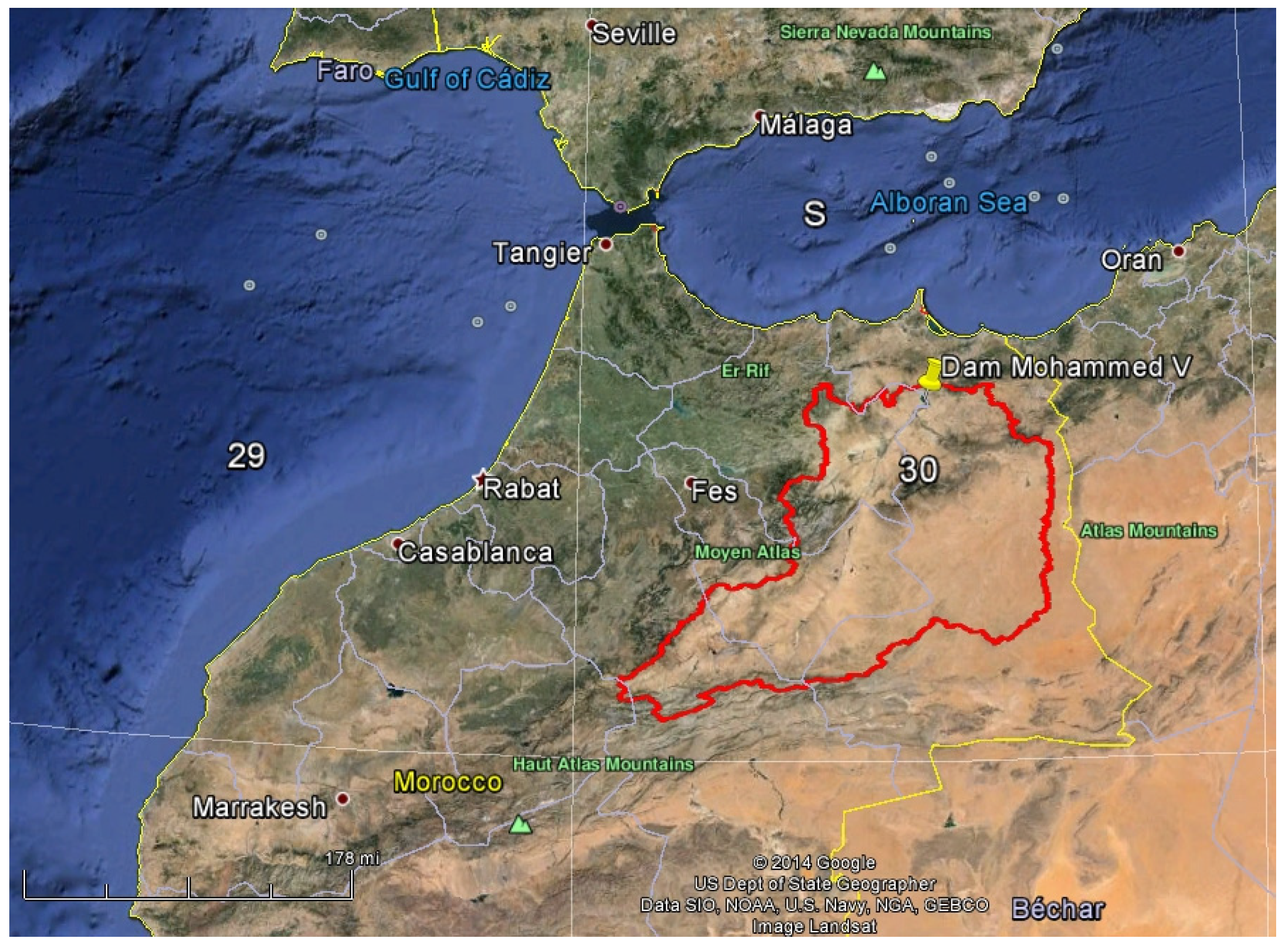
2.2. Data Sets
| Sensor | Date | Sensor | Date | Footprint: Path/Row |
|---|---|---|---|---|
| Landsat 5 TM | 27 August 1984 | Landsat 8 OLI | 26 July 2013 | 200/36 |
| Landsat 5 TM | 27 August 1984 | Landsat 8 OLI | 26 July 2013 | 200/37 |
| Landsat 5 TM | 27 August 1984 | Landsat 8 OLI | 26 July 2013 | 200/38 |
| Landsat 5 TM | 7 October 1984 | Landsat 8 OLI | 4 August 2013 | 199/36 |
| Landsat 5 TM | 7 October 1984 | Landsat 8 OLI | 4 August 2013 | 199/37 |
3. Methods
3.1. Image Pre-Processing
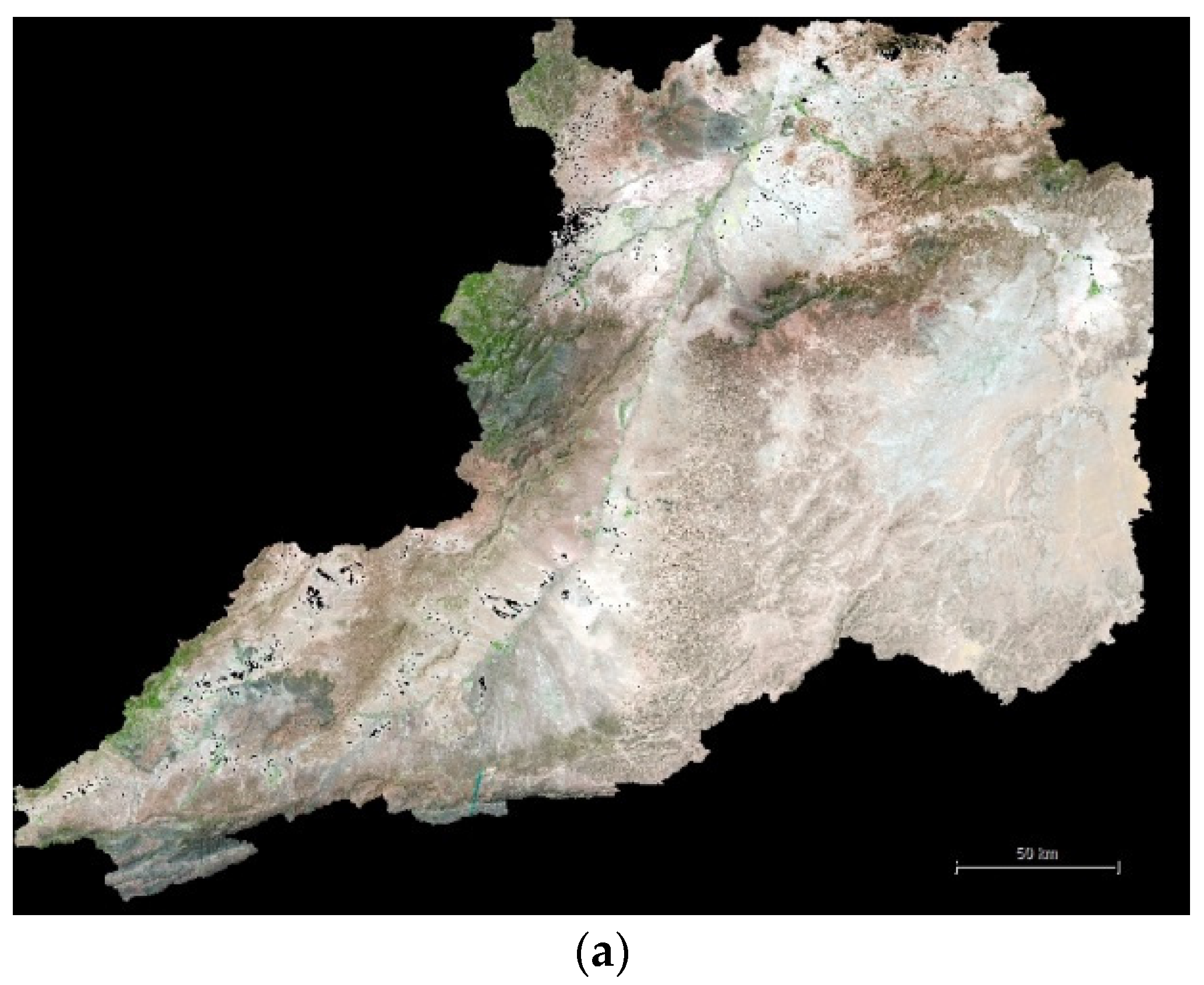
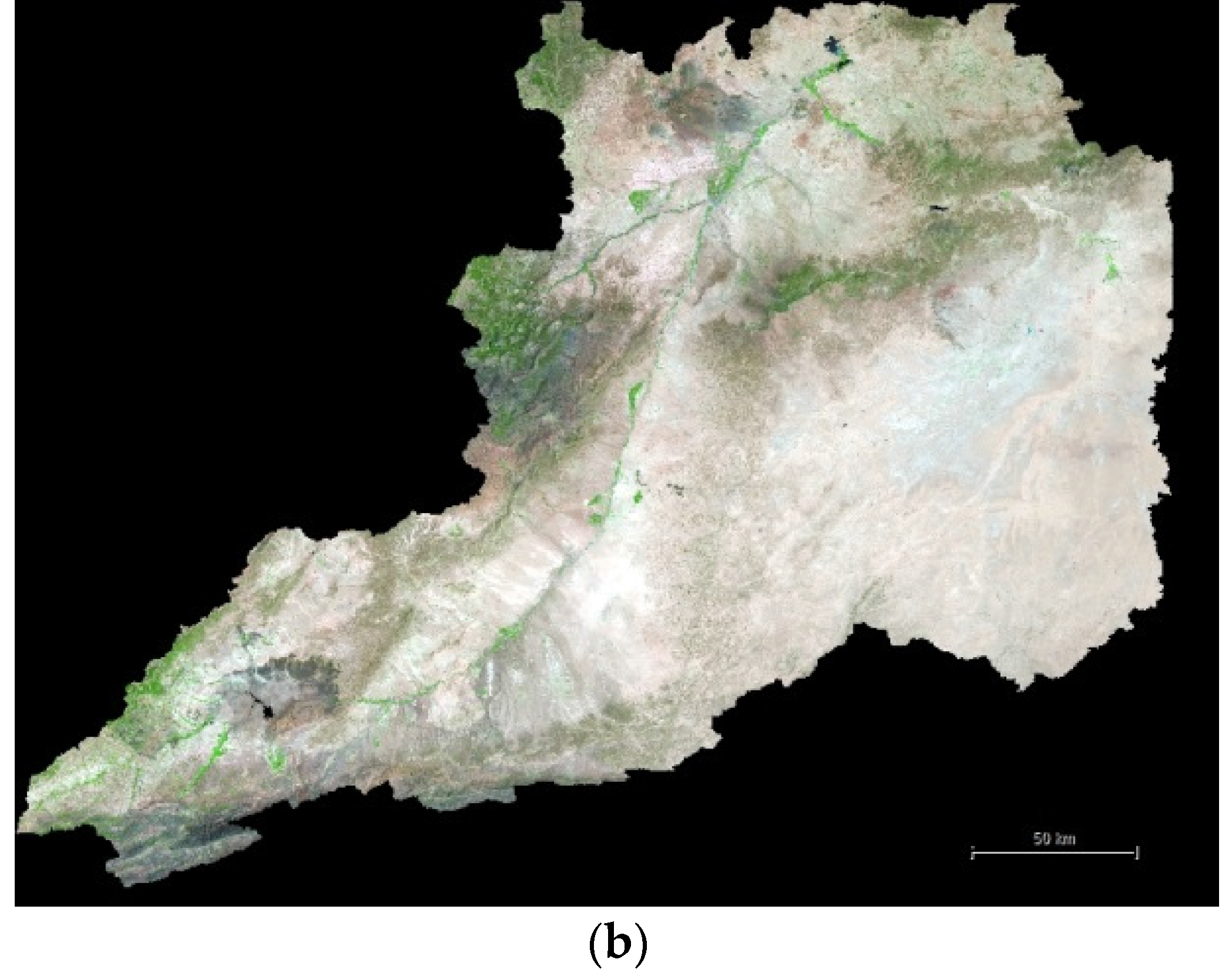
3.2. Spectral Mixture Analysis (Subpixel Approach)
3.3. Image Segmentation (Object-Based Approach)
3.4. Features Vector Used to Carry Out Object-Based Classification
| Type of Feature | Name | Description |
|---|---|---|
| Spectral (Landsat bands) | Mean reflectance for Blue, Green, Red, Nir, Swir1, and Swir2 Landsat bands | Mean value for every object computed from the corresponding reflectance values of all the pixels belonging to the same object [47] |
| Standard deviation reflectance for Blue, Green, Red, Nir, Swir1 and Swir2 Landsat bands | Standard deviation (SD) value for every object computed from the corresponding reflectance values of all the pixels belonging to the same object [47] | |
| Vegetation indices | NDVI (Normalized Digital Vegetation Index) [52] | |
| MSR (Modified Simple Ratio) [53] | ||
| NDSVI (Normalized Differential Senescent Vegetation Index) [54] | ||
| GVI (Green Vegetation Index) [55] | ||
| SMA derived | Fraction PV, Fraction NPV and Fraction Soil | Mean value for every object computed from the corresponding SMA fraction of all the pixels belonging to the same object [47] |
| Standard deviation Fraction PV, Fraction NPV and Fraction Soil | Standard deviation (SD) value for every object computed from the corresponding SMA fraction of all the pixels belonging to the same object [47] |
3.5. Random Forest Classifier and Classification Accuracy Assessment
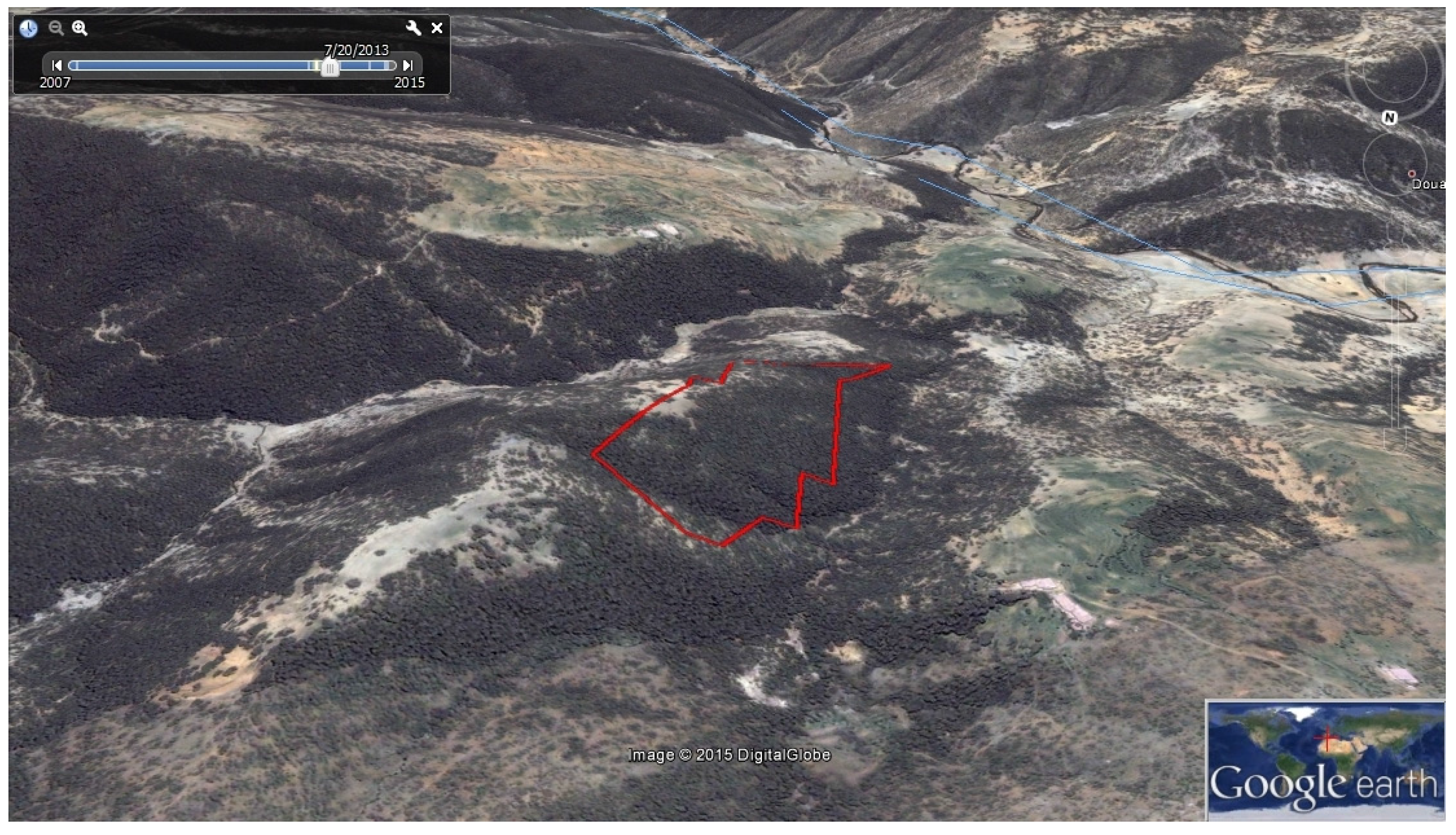
4. Results and Discussion
4.1. Results from Random Forest Classification Including All Object-Based Features
| Features | Relative Importance |
|---|---|
| NDVI_2013 | 100.00 |
| Mean Green_2013 | 92.08 |
| Mean Swir2_2013 | 90.53 |
| MSR_2013 | 86.35 |
| Fraction PV 2013 | 86.14 |
| Mean Red_2013 | 82.57 |
| Fraction Soil 2013 | 79.92 |
| Mean Blue_2013 | 71.63 |
| Fraction NPV 2013 | 71.57 |
| GVI_2013 | 68.37 |
| NDSVI_2013 | 68.34 |
| Standard deviation Fraction NPV 2013 | 61.10 |
| Standard deviation Fraction PV 2013 | 60.36 |
| Mean Nir_2013 | 58.42 |
| Mean Swir1_2013 | 55.06 |
| Standard deviation Swir1_2013 | 45.58 |
| Standard deviation Fraction Soil 2013 | 44.91 |
| Standard deviation Nir_2013 | 41.44 |
| Standard deviation Red_2013 | 37.58 |
| Standard deviation Blue_2013 | 32.98 |
| Standard deviation Swir2_2013 | 31.66 |
| Standard deviation Green_2013 | 24.90 |
| Classification Data Predicted by Random Forest Model | Total | |||
|---|---|---|---|---|
| Forest | Non-Forest | |||
| Observed Data (Ground Truth) | Forest | 122 | 22 | 144 |
| Non-Forest | 22 | 238 | 260 | |
| Total | 144 | 260 | 404 | |
| User’s accuracy | Producer’s accuracy | Overall accuracy | ||
| Forest | 84.7% (CI: 77.8% to 90.2%) | 84.7% (CI: 77.8% to 90.2%) | 89.1% (CI: 85.7% to 92.0%) | |
| Non-Forest | 91.5% (CI: 87.5% to 94.6%) | 91.5% (CI: 87.5% to 94.6%) | ||
4.2. Results from Random Forest Classification Only Including Object-Based Indices’ Features
| Features | Importance |
|---|---|
| NDVI_2013 | 100.00 |
| Fraction PV 2013 | 97.70 |
| Fraction Soil 2013 | 83.43 |
| GVI_2013 | 77.34 |
| MSR_2013 | 75.31 |
| NDSVI_2013 | 74.85 |
| Fraction_NPV_2013 | 61.54 |
| Classification Data Predicted by Random Forest Model | Total | |||
|---|---|---|---|---|
| Forest | Non-Forest | |||
| Observed data (Ground Truth) | Forest | 127 | 15 | 142 |
| Non-Forest | 16 | 247 | 263 | |
| Total | 143 | 262 | 405 | |
| User’s accuracy | Producer’s accuracy | Overall accuracy | ||
| Forest | 88.8% (CI: 82.5% to 93.5%) | 89.4% (CI: 83.2% to 94.0%) | 92.3% (CI: 89.3% to 94.7%) | |
| Non-Forest | 94.3% (CI: 90.7% to 96.8%) | 93.9% (CI: 90.3% to 96.5%) | ||
4.3. Forest Cover Change between 1984 and 2013
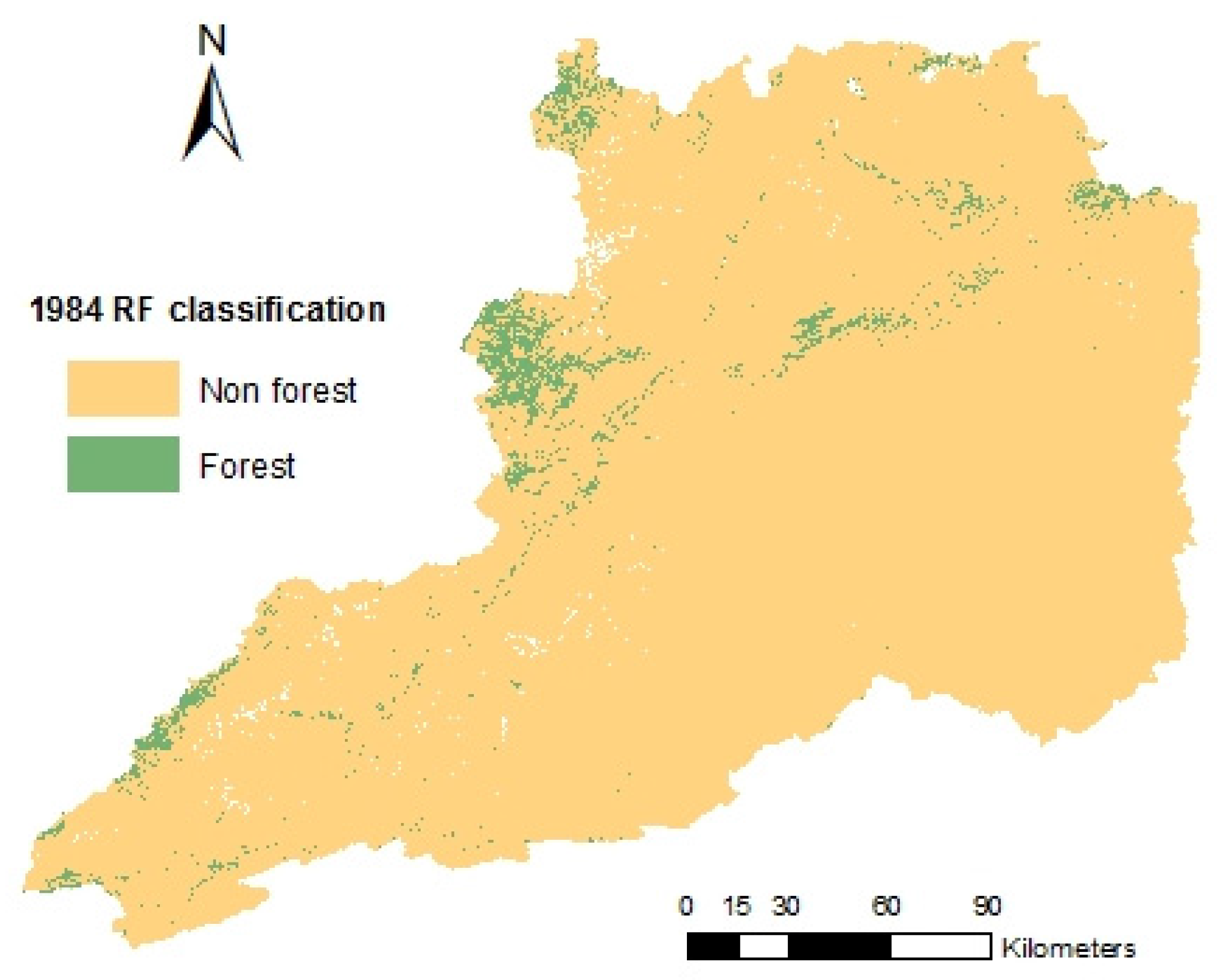

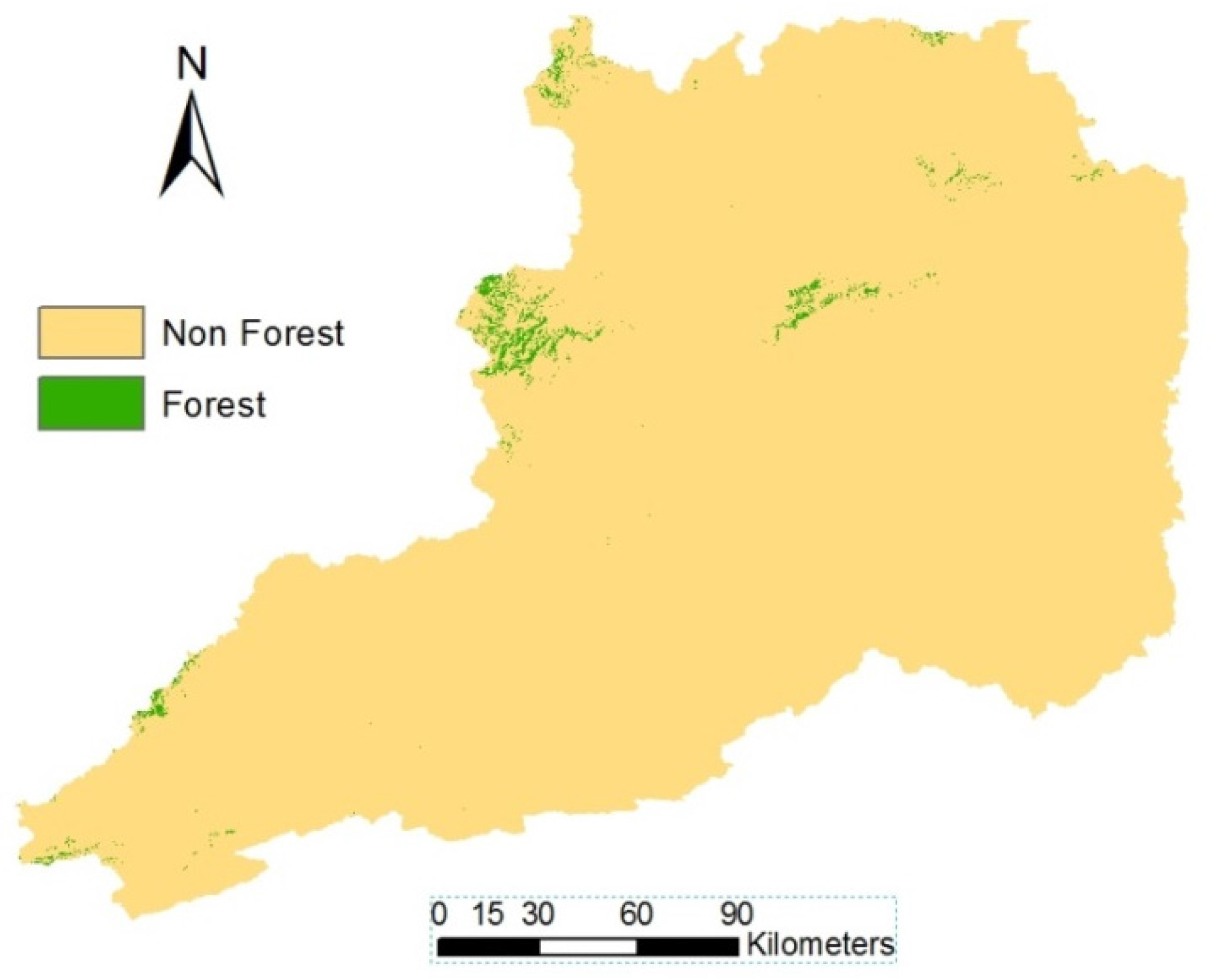
5. Conclusions
Acknowledgments
Author Contributions
Conflicts of Interest
References
- Dixon, R.K.; Houghton, R.A.; Solomon, A.M.; Trexler, M.C.; Wisniewski, J. Carbon pools and flux of global forest ecosystems. Science 1994, 263, 185–190. [Google Scholar] [CrossRef] [PubMed]
- Barker, T.; Bashmakov, I.; Bernstein, L.; Bogner, J.E.; Bosch, P.; Rutu, D.; Ogunlade, D.; Fisher, B.S.; Gupta, S.; Halsnaes, K.; et al. Technical Summary in Climate Change 2007: Mitigation. Contribution of Working Group III to the Fourth Assessment Report of the Intergovernmental Panel on Climate Change; Cambridge University Press: Cambridge, UK; New York, NY, USA, 2007. [Google Scholar]
- Nemmaoui, A.; García-Lorca, A.M.; Aguilar, F.J.; Aguilar, M.A. Time series of vegetation for a destroyed forest model. The case of Tadla Azilal (Morocco). Agrociencia 2013, 47, 267–280. [Google Scholar]
- Andréassian, V. Waters and forests: from historical controversy to scientific debate. J. Hydrol. 2004, 291, 1–27. [Google Scholar] [CrossRef]
- Geeson, N.A.; Brandt, C.J.; Thornes, J.B. Mediterranean Desertification: A Mosaic of Processes and Responses; John Wiley & Sons: England, UK, 2003. [Google Scholar]
- Saldaña, M.M.; Nemmaoui, A.; Cantón, M.Y.; Aguilar, M.A.; Aguilar, F.J. Estimation of the potential erosion in the Moulouya River watershed upstream of the dam Mohammed V. Mapping 2015, 168, 4–16. [Google Scholar]
- Rosenzweig, C.; Strzepek, K.M.; Major, D.C.; Iglesias, A.; Yates, D.N.; McCluskey, A.; Hillel, D. Water resources for agriculture in a changing climate: International case studies. Global Environ. Chang. 2004, 14, 345–360. [Google Scholar] [CrossRef]
- Orindi, V.A.; Murray, L.A. Adapting to Climate Change in East Africa: A Strategic Approach; Gatekeeper Series No. 117; International Institute for Environment and Development: London, UK, 2005. [Google Scholar]
- Dong, J.; Kaufmann, R.K.; Myneni, R.B.; Tucker, C.J.; Kauppi, P.E.; Liski, J.; Buermann, W.; Alexeyev, V.; Hughes, M.K. Remote sensing estimates of boreal and temperate forest woody biomass: Carbon pools, sources, and sinks. Remote Sens. Environ. 2003, 84, 393–410. [Google Scholar] [CrossRef]
- Hudiburg, T.; Law, B.; Turner, D.P.; Campbell, J.; Donato, D.; Duane, M. Carbon dynamics of Oregon and Northern California forests and potential land-based carbon storage. Ecol. Appl. 2009, 19, 163–180. [Google Scholar] [CrossRef] [PubMed]
- Luyssaert, S.; Schulze, E.D.; Borner, A.; Knohl, A.; Hessenmoller, D.; Law, B.E.; Ciais, P.; Grace, J. Old-growth forests as global carbon sinks. Nature 2008, 455, 213–215. [Google Scholar] [CrossRef] [PubMed]
- Balderas Torres, A.; Ontiveros Enríquez, R.; Skutsch, M.; Lovett, J.C. Potential for Climate Change Mitigation in Degraded Forests: A Study from La Primavera, Mexico. Forests 2013, 4, 1032–1054. [Google Scholar] [CrossRef]
- Stephens, P.; Watt, P.; Loubser, D.; Haywood, A.; Kimberley, M. Estimation of carbon stocks in New Zealand planted forests using airborne scanning lidar. International Archives of Photogrammetry. Remote Sens. Spat. Inf. Sci. 2007, 36, 389–394. [Google Scholar]
- Boulmane, M.; Makhloufi, M.; Bouillet, J.P.; Saint-André, L.; Satrani, B.; Halim, M. Estimation du stock de carbone organique dans les Quercus ilex du Moyen Atlas Marocain. Acta Bot. Gallica 2010, 157, 451–467. [Google Scholar] [CrossRef]
- Hansen, M.C.; Loveland, T.R. A review of large area monitoring of land cover change using Landsat data. Remote Sens. Environ. 2012, 122, 66–74. [Google Scholar] [CrossRef]
- Xian, G.; Homer, C.; Fry, J. Updating the 2001 National Land Cover Database land cover classification to 2006 by using Landsat imagery change detection methods. Remote Sens. Environ. 2009, 113, 1133–1147. [Google Scholar] [CrossRef]
- Wulder, M.A.; Franklin, S.E. Understanding Forest Disturbance and Spatial Pattern: Remote Sensing and GIS Approaches; Taylor & Francis: Boca Ratón, FL, USA, 2007. [Google Scholar]
- Kennedy, R.E.; Yang, Z.; Cohen, W.B. Detecting trends in forest disturbance and recovery using yearly Landsat time series: 1. LandTrendr-Temporal segmentation algorithms. Remote Sens. Environ. 2010, 114, 2897–2910. [Google Scholar] [CrossRef]
- Huang, C.; Goward, S.N.; Schleeweis, K.; Thomas, N.; Masek, J.G.; Zhu, Z. Dynamics of national forests assessed using the Landsat record: Case studies in eastern United States. Remote Sens. Environ. 2009, 113, 1430–1442. [Google Scholar] [CrossRef]
- Pang, C.; Yu, H.; He, J.; Xu, J. Deforestation and Changes in Landscape Patterns from 1979 to 2006 in Suan County, DPR Korea. Forests 2013, 4, 968–983. [Google Scholar] [CrossRef]
- Hansen, M.C.; Potapov, P.V.; Moore, R.; Hancher, M.; Turubanova, S.A.; Tyukavina, A.; Thau, D.; Stehman, S.V.; Goetz, S.J.; Loveland, T.R.; et al. High-Resolution Global Maps of 21st-Century Forest Cover Change. Science 2013, 342, 850–853. Available online: http://earthenginepartners.appspot.com/science-2013-global-forest (accessed on 15 December 2015). [Google Scholar] [CrossRef] [PubMed]
- Robertson, L.D.; King, D.J. Comparison of pixel- and object-based classification in land cover change mapping. Int. J. Remote Sens. 2011, 32, 1505–1529. [Google Scholar] [CrossRef]
- Vieira, M.A.; Formaggio, A.R.; Rennó, C.D.; Atzberger, C.; Aguiar, D.A.; Mello, M.P. Object Based Image Analysis and Data Mining applied to a remotely sensed Landsat time-series to map sugarcane over large areas. Remote Sens. Environ. 2012, 123, 553–562. [Google Scholar] [CrossRef]
- Campbell, M.; Congalton, R.G.; Harter, J.; Ducey, M. Optimal Land Cover Mapping and Change Analysis in Northeastern Oregon Using Landsat Imagery. Photogramm. Eng. Remote Sens. 2015, 81, 37–47. [Google Scholar] [CrossRef]
- Fisher, P. The pixel: A snare and a delusion. Int. J. Remote Sens. 1997, 18, 679–685. [Google Scholar] [CrossRef]
- Cracknell, A.P. Synergy in remote sensing—What’s in a pixel? Int. J. Remote Sens. 1998, 19, 2025–2047. [Google Scholar] [CrossRef]
- Foody, G.M.; Cox, D.P. Sub-pixel land cover composition estimation using a linear mixture model and fuzzy membership functions. Int. J. Remote Sens. 1994, 15, 619–631. [Google Scholar] [CrossRef]
- Woodcock, C.E.; Gopal, S. Fuzzy set theory and thematic maps: Accuracy assessment and area estimation. Int. J. Geogr. Inf. Sci. 2000, 14, 153–172. [Google Scholar] [CrossRef]
- Asner, G.P.; Lobell, D.B. A biogeophisical approach for automated SWIR unmixing of soils and vegetation. Remote Sens. Environ. 2000, 74, 99–112. [Google Scholar] [CrossRef]
- Haut Commissaire aux Eaux et Forêts et à la Lutte Contre la Désertification. Bilan des Réalisations du Programme Décennal (2005–2009); HCEFLCD/DPSIC/DSI/SSE: Rabat, Morocco, 2009. Available online: http://www.eauxetforets.gov.ma/admin/telechargement/fr/Bilan_2005_2009_programme_d%C3%A9cennal_forestier.pdf (accessed on 9 July 2014).
- FAO. Global Forest Resources Assessment Update 2005. Terms and Definition. Forest Resources Assessment Programme; Working Paper 83; FAO: Roma, Italy, 2005. [Google Scholar]
- Woodcock, C.E.; Allen, R.; Anderson, M.; Belward, A.; Bindschadler, R.; Cohen, W.B.; Gao, F.; Goward, S.N.; Helder, D.; Helmer, E.; et al. Free access to Landsat imagery. Science 2008, 320, 1011. [Google Scholar] [CrossRef] [PubMed]
- Song, C.; Woodcock, C.E.; Seto, K.C.; Lenney, M.P.; Macomber, S.A. Classification and change detection using Landsat TM data: When and how to correct atmospheric effects? Remote Sens. Environ. 2001, 75, 230–244. [Google Scholar] [CrossRef]
- Vermote, E.F.; Tanre, D.; Deuze, J.L.; Herman, M.; Morcrette, J.J. Second simulation of the satellite signal in the solar spectrum, 6S: An overview. IEEE Trans. Geosci. Remote Sens. 1997, 35, 675–686. [Google Scholar] [CrossRef]
- Asner, G.P.; Knapp, D.E.; Balaji, A.; Páez-Acosta, G. Automated mapping of tropical deforestation and forest degradation: CLASlite. J. Appl. Remote Sens. 2009, 3, 1–24. [Google Scholar] [CrossRef]
- Lu, D.; Moran, E.; Hetrick, S. Detection of impervious surface change with multi-temporal Landsat images in an urban-rural frontier. ISPRS J. Photogramm. Remote Sens. 2011, 66, 298–306. [Google Scholar] [CrossRef] [PubMed]
- Lu, D.; Moran, E.; Batistella, M. Linear mixture model applied to Amazonian vegetation classification. Remote Sens. Environ. 2003, 87, 456–469. [Google Scholar] [CrossRef]
- Small, C. The Landsat ETM+ spectral mixing space. Remote Sens. Environ. 2004, 93, 1–17. [Google Scholar] [CrossRef]
- Elmore, A.J.; Mustard, J.F.; Manning, S.J.; Lobell, D.B. Quantifying vegetation change in semiarid environments. Remote Sens. Environ. 2000, 44, 87–102. [Google Scholar] [CrossRef]
- Asner, G.P. Biophysical and biochemical sources of variability in canopy reflectance. Remote Sens. Environ. 1998, 64, 234–253. [Google Scholar] [CrossRef]
- Asner, G.P.; Heidebrecht, K.B. Spectral unmixing of vegetation, soil and dry carbon cover in arid regions: comparing multispectral and hyperspectral observations. Int. J. Remote Sens. 2002, 23, 3939–3958. [Google Scholar] [CrossRef]
- Asner, G.P.; Keller, M.; Pereira, R.; Zweede, J.C.; Silva, J.N. Canopy damage and recovery after selective logging in Amazonia: Field and satellite studies. Ecol. Appl. 2004, 14, 280–298. [Google Scholar] [CrossRef]
- Asner, G.P.; Knapp, D.E.; Broadbent, E.N.; Oliveira, P.J.C.; Keller, M.; Silva, J.N. Selective logging in the Brazilian Amazon. Science 2005, 310, 480–482. [Google Scholar] [CrossRef] [PubMed]
- Blaschke, T. Object based image analysis for remote sensing. ISPRS J. Photogramm. Remote Sens. 2010, 65, 2–16. [Google Scholar] [CrossRef]
- Baatz, M.; Schäpe, A. Multiresolution segmentation. In Angewandte Geographische Informationsverarbeitung XII: Beiträge zum AGIT-Symposium Salzburg 2000 (German Edition); Strobl, J., Blaschke, T., Griesebner, G., Eds.; Wichmann-Verlag: Heidelberg, Germany, 2000; pp. 12–23. [Google Scholar]
- Tian, J.; Chen, D.M. Optimization in multi-scale segmentation of high-resolution satellite images for artificial feature recognition. Int. J. Remote Sens. 2007, 28, 4625–4644. [Google Scholar] [CrossRef]
- Trimble Germany GmbH. eCognition Developer 8.8 Reference Book; Trimble Germany GmbH: Munich, Germany, 2012. [Google Scholar]
- Peña-Barragán, J.M.; Gutiérrez, P.A.; Hervás-Martínez, C.; Six, J.; Plant, R.E.; López-Granados, F. Object-based image classification of summer crops with machine learning methods. Remote Sens. 2014, 6, 5019–5041. [Google Scholar] [CrossRef]
- Lu, D.; Weng, Q. A survey of image classification methods and techniques for improving classification performance. Int. J. Remote Sens. 2007, 28, 823–870. [Google Scholar] [CrossRef]
- Chen, D.; Stow, D.A.; Gong, P. Examining the effect of spatial resolution and texture window size on classification accuracy: An urban environment case. Int. J. Remote Sens. 2004, 25, 2177–2192. [Google Scholar] [CrossRef]
- Aguilar, M.A.; Vallario, A.; Aguilar, F.J.; García Lorca, A.; Parente, C. Object-Based greenhouse horticultural crop identification from multi-temporal satellite imagery: A case study in Almeria, Spain. Remote Sens. 2015, 7, 7378–7401. [Google Scholar] [CrossRef]
- Rouse, J.W.; Haas, R.H.; Schell, J.A.; Deering, D.W. Monitoring vegetation systems in the Great Plains with ERTS. In Proceedings of the Earth Resources Technology Satellite Symposium NASA SP-351, Washington, DC, USA, 10–14 December 1973; Volume 1, pp. 309–317.
- Chen, J. Evaluation of vegetation indices and modified simple ratio for boreal applications. Can. J. Remote Sens. 1996, 22, 229–242. [Google Scholar] [CrossRef]
- Qi, J.; Marsett, R.; Heilman, P.; Biedenbender, S.; Moran, S.; Goodrich, D. RANGES improves satellite-based information and land cover assessment in southwest United States. Trans. Am. Geophys. Union 2002, 83, 601–606. [Google Scholar] [CrossRef]
- Gitelson, A.A.; Kaufman, Y.J.; Stark, R.; Rundquist, D. Novel algorithms for remote estimation of vegetation fraction. Remote Sens. Environ. 2002, 80, 76–87. [Google Scholar] [CrossRef]
- Breiman, L. Random forest. Mach. Learn. 2001, 45, 5–32. [Google Scholar] [CrossRef]
- Rodríguez-Galiano, V.F.; Ghimire, B.; Rogan, J.; Chica-Olmo, M.; Rigol-Sánchez, J.P. An assessment of the effectiveness of a random forest classifier for land-cover classification. ISPRS J. Photogramm. Remote Sens. 2012, 67, 93–104. [Google Scholar] [CrossRef]
- Smith, A. Image segmentation scale parameter optimization and land cover classification using the Random Forest algorithm. J. Spat. Sci. 2010, 55, 69–79. [Google Scholar] [CrossRef]
- Breiman, L.; Friedman, J.; Stone, C.J.; Olshen, R.A. Classification and Regression Trees, 1st ed.; Chapman and Hall/CRC: Belmont, CA, USA, 1984. [Google Scholar]
- Hill, T.; Lewicki, P. Statistics: Methods and Applications; StatSoft: Tulsa, OK, USA, 2007. [Google Scholar]
- Congalton, R.G. A review of assessing the accuracy of classifications of remotely sensed data. Remote Sens. Environ. 1991, 37, 35–46. [Google Scholar] [CrossRef]
- Sauro, J.; Lewis, J.R. Estimating completion rates from small samples using binomial confidence intervals: Comparisons and recommendations. In Proceedings of the Human Factors and Ergonomics Society 49th annual meeting, Orlando, FL, USA, 26–30 September 2005; pp. 2100–2104.
- Turner, D.P.; Cohen, W.B.; Kennedy, R.E.; Fassnacht, K.S.; Briggs, J.M. Relationships between Leaf Area Index and Landsat TM Spectral Vegetation Indices across three temperate zone sites. Remote Sens. Environ. 1999, 70, 52–68. [Google Scholar] [CrossRef]
- Congalton, R.G.; Green, K. Assessing the Accuracy of Remotely Sensed Data, 2nd ed.; CRC Press: Boca Ratón, FL, USA, 2009. [Google Scholar]
- Foody, G.M. Status of land cover classification accuracy assessment. Remote Sens. Environ. 2002, 80, 185–201. [Google Scholar] [CrossRef]
- Yang, J.; Honavar, V. Feature subset selection using a genetic algorithm. IEEE Intell. Syst. 1998, 13, 44–49. [Google Scholar] [CrossRef]
- Lawrence, R.L.; Wood, S.D.; Sheley, R.L. Mapping invasive plants using hyperspectral imagery and Breiman Cutler classifications (Random Forest). Remote Sens. Environ. 2006, 100, 356–362. [Google Scholar] [CrossRef]
- Na, X.; Zhang, S.; Li, X.; Yu, H.; Liu, C. Improved land cover mapping using random forest combined with Landsat Thematic Mapper imagery and ancillary geographic data. Photogramm. Eng. Remote Sens. 2010, 76, 833–840. [Google Scholar] [CrossRef]
- Chan, J.C.; Paelinckx, D. Evaluation of random forest and AdaBoost tree-based ensemble classification and spectral band selection for ecotope mapping using airborne hyperspectral imagery. Remote Sens. Environ. 2008, 112, 2999–3011. [Google Scholar] [CrossRef]
- Mountrakis, G.; Im, J.; Ogole, C. Support vector machines in remote sensing: A review. ISPRS J. Photogramm. Remote Sens. 2011, 66, 247–259. [Google Scholar] [CrossRef]
© 2016 by the authors; licensee MDPI, Basel, Switzerland. This article is an open access article distributed under the terms and conditions of the Creative Commons by Attribution (CC-BY) license (http://creativecommons.org/licenses/by/4.0/).
Share and Cite
Aguilar, F.J.; Nemmaoui, A.; Aguilar, M.A.; Chourak, M.; Zarhloule, Y.; García Lorca, A.M. A Quantitative Assessment of Forest Cover Change in the Moulouya River Watershed (Morocco) by the Integration of a Subpixel-Based and Object-Based Analysis of Landsat Data. Forests 2016, 7, 23. https://doi.org/10.3390/f7010023
Aguilar FJ, Nemmaoui A, Aguilar MA, Chourak M, Zarhloule Y, García Lorca AM. A Quantitative Assessment of Forest Cover Change in the Moulouya River Watershed (Morocco) by the Integration of a Subpixel-Based and Object-Based Analysis of Landsat Data. Forests. 2016; 7(1):23. https://doi.org/10.3390/f7010023
Chicago/Turabian StyleAguilar, Fernando J., Abderrahim Nemmaoui, Manuel A. Aguilar, Mimoun Chourak, Yassine Zarhloule, and Andrés M. García Lorca. 2016. "A Quantitative Assessment of Forest Cover Change in the Moulouya River Watershed (Morocco) by the Integration of a Subpixel-Based and Object-Based Analysis of Landsat Data" Forests 7, no. 1: 23. https://doi.org/10.3390/f7010023
APA StyleAguilar, F. J., Nemmaoui, A., Aguilar, M. A., Chourak, M., Zarhloule, Y., & García Lorca, A. M. (2016). A Quantitative Assessment of Forest Cover Change in the Moulouya River Watershed (Morocco) by the Integration of a Subpixel-Based and Object-Based Analysis of Landsat Data. Forests, 7(1), 23. https://doi.org/10.3390/f7010023








